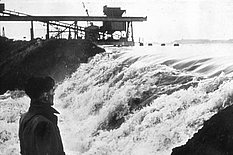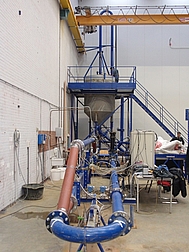Erosion of sand under high flow velocities
Rick Bisschop
Background
In case of flooding of a polder, the inundation rate is one of the determining factors in predicting the resulting damage (casualties, damage infrastructure, economic damage, etc.). The inundation rate depends heavily on the flow velocity through the breach in the dike and the development of the breach in time, so on the process of erosion of the dike material. Existing sediment erosion formulae, like the Van Rijn formula (Van Rijn, 1993), overestimate the erosion rate of the breach in case of non-cohesive dike material. The same difference is encountered in dredging practice. Trailing suction hopper dredgers extract sand from the sea bed for reclamation purposes. As in the breaching process, the conventional erosion functions overestimate the erosion rate during jetting.

Trailing suction hopper dredgers

Breaching of a dike (1953)
Sediment erosion formulae like that of Van Rijn are basically pick-up functions of single particles in case of relative low flow velocities (0.5 to 2.0 m/s). Flow velocities in dike breaches can increase to approximately 10 m/s. Typical flow velocities during jetting sand using a trailing suction hopper dredger are around 30 to 60 m/s. At these large flow velocities the erosion process is significantly influenced by the properties of the soil mass (non-cohesive particles). Governing parameters at higher flow velocities are dilatancy, permeability and the (un)drained shear strength of the soil (“hindered erosion”).
Objective
The aim of this research project is to determine the physical process of erosion under high flow velocities on the basis of the results of laboratory erosion tests. These tests are aimed at the influence of the properties like permeability and density of sand on the erosion process at different flow velocities.
Approach
The PhD-study comprises of different steps:
Literature survey for gathering:
- Erosion data (mainly based on sheet flow measurements);
- Models to determine the velocity profile, bed roughness and shear stress in and above sheet flow layers and models describing the behavior of sand;
- Models describing the behavior of sand as a result of shear stresses;
Develop test equipment for performing erosion tests:
- Design of test equipment including determination type of measurements instruments;
- Construction of test equipment;
- Performing calibration tests and determine test method.
Laboratory erosion tests:
- Improve test equipment and method on the basis of the first calibration tests;
- Performing erosion tests including high speed film;
- Analysis of data;
- Describe physical process of erosion on the basis of the data and film.
Modeling erosion process:
- Determine different models for the different physical processes during erosion;
- Develop an integral model.

Test equipment erosion tests
Funding
This research subject is financially supported by Royal Boskalis Westminster Dredging BV, Van Oord and Marine Contractors BV, IHC Merwede BV, Cornelis Lely Stichting and ARCADIS. The research is executed in cooperation between the Faculty of Mechanical Engineering and Marine Technology and the Faculty of Civil Engineering and Geosciences.
Contact
- Rik Bisschop – Senior Geotechnical Specialist/PhD student - ARCADIS/TU Delft 06-27061397
- Sape Miedema – Associate Professor - TU Delft
- Cees van Rhee – Professor - TU Delft (015-2783973/06-53837686) – C.vanRhee@tudelft.nl
- Paul Visser – Associate Professor - TU Delft (015-2788005) – P.J.Visser@tudelft.nl